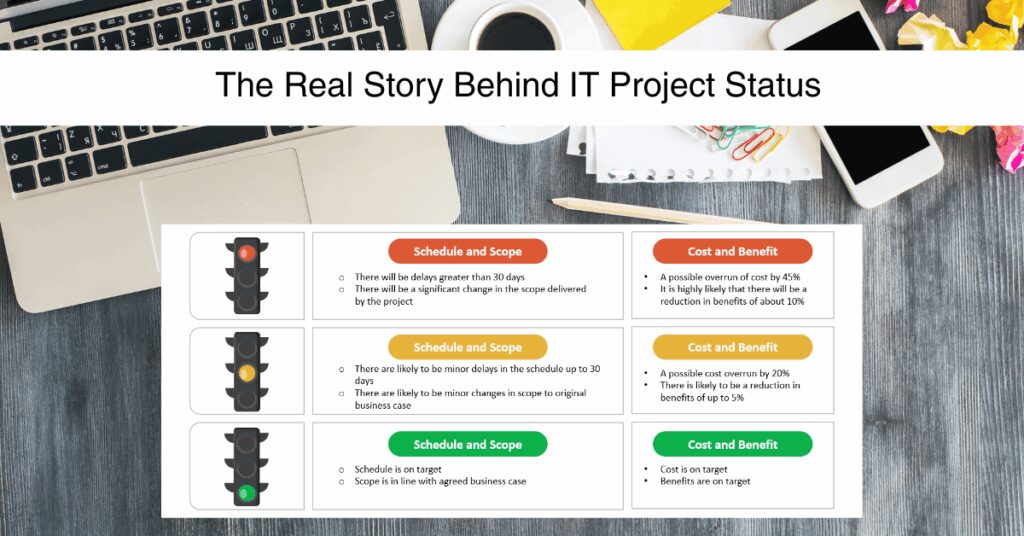We all know the RAG system — Red, Amber, Green — three colours on a dashboard that appear to sum up a project’s fate. Seasoned project managers know the truth though: the real story isn’t in the colour; it’s in what happens behind the scenes.
Clues in the hues!
In a LinkedIn post, Anjum Biradar (a positive and insightful voice in the project management community) reminds us that great delivery isn’t about keeping everything green at all costs. It’s about leadership, perseverance and engaging stakeholders — especially when the project turns amber or red. So …
Green doesn’t mean perfect. It often means a project manager has quietly managed risks and resolved issues before they escalated.
Amber isn’t bad news. It signals transparency, early warning, space for recovery and opportunities to learn and grow — as a team and as an individual.
Red isn’t failure. It’s a call for decisions, resources and collaboration to get back on track. As my PM friend Malc always says, “Red is where we get to really see what we’re made of!”
I’ve often wondered whether we need a better system! While teams with a growth mindset respond well to the cues delivered by the RAG system, others are paralysed. I’ve seen teams so deflated by their project dipping into red that the project failed—not because of the reason why it strayed into the red—but due to how they reacted after it did.
One PM friend is experimenting with a different model at the moment, after she joined a team who did suffer “red-led-paralysis” (as she called it).
“The red of RAG actually has no meaning apart from the meaning that you attach to it,” Becki told me. “I’ve always attached a positive meaning – a call to roll up your sleeves and draw upon all the resilience and experience in your tank. My new team would throw a complete wobbly and freeze. RAG had to go.”
What Becki has introduced is a colour-based status system inspired by Edward de Bono’s Six Thinking Hats to reduce paralysis often triggered by “red” in traditional RAG dashboards. In her new model, each hat colour represents a unique mindset, encouraging teams to explore challenges and progress from several angles—collaboratively and without judgment. And yes, they actually wear different colour hats.
- Instead of a single “traffic light” for project health, teams self-select which hat is most valuable for their weekly status discussion.
- Leaders prompt the team with the hat’s question to drive constructive conversation, e.g., “Let’s spend our standup under the Yellow Hat: What wins or progress can we build on this week?”
- If a challenge emerges, the team might shift to the Green Hat, brainstorming solutions without fear of judgment or perceived “failure.”
- The Blue Hat organises the wrap-up, setting actions—removing the stigma of “red” and focusing instead on the right mindset for progress.
It’s early days but Becki says her system is already “building resilience” and has given the team “psychological safety” and “a more productive direction”. Who doesn’t love wearing a coloured hat?!
Becki’s observation on resilience is worth highlighting, whether you’re using a traditional RAG system or wearing different hats, resilience is your super-power.
As Anjum puts it in another LinkedIn post, “As project managers, our edge is not just in methodologies or certifications it’s in resilience. The ability to lead through uncertainty, to push forward when the path is foggy, and to inspire our teams to keep moving one milestone at a time.”
The more resilience you can build into your project eco-system when things are green, the better you’ll respond when the “red fog” descends.
The Real Measure of Success
Let’s be clear: Success in project management isn’t about never going red.
What sets great leaders apart is how they guide a project out of the red, back into amber, and ultimately to green. Navigating these transitions demands strong communication, stakeholder management and an openness to adapt plans.
Having been in the thick of red-status projects, the most valuable lesson is this: red creates opportunity to learn and improve. It surfaces issues early, invites collaboration and, handled well, can strengthen relationships with sponsors.
Green projects are celebrated, but it’s the red ones that test leadership and build organisational resilience.
Why Projects Go ‘Red’ — And How to Respond
Projects turn red for many reasons: shifting priorities, scope changes, resource gaps or risks nobody foresaw.
The real question is, what next?
In traditional settings, getting back to green can be slow, limited by internal bottlenecks and a lack of fresh perspective. This is where I’ll take a leaf out of Becki’s book, and put on my sales hat for a moment, because this is where “Project Management as a Service” (PMaaS) can flip the script!
Project Management as a Service: Turning Red to Green
PMaaS is a flexible, scalable and cost-effective model that delivers project management capabilities — expertise, tools and processes — as a service. Rather than relying solely on permanent internal staff, businesses can bring in exactly the right skills at the right time.
… but what makes PMaaS a RAG game changer?
I’m glad you asked:
Cost efficiency: Organisations only pay for the project services they use, avoiding the expense of maintaining a large internal team year-round.
Flexibility and scalability: Whether managing one project or a whole portfolio, organisations can scale up or down easily in response to changing needs.
Access to expertise: PMaaS providers bring in-depth, cross-industry knowledge, proven methodologies and best practice — often flagging risks earlier and suggesting innovative solutions.
Focus on core business: Teams can stay committed to their strategic priorities, while experienced PMs handle delivery, reporting and stakeholder communication.
Faster, more reliable delivery: Senior PMs, unencumbered by internal politics, focus only on delivering outcomes, leading to improved timelines, budget adherence and, crucially, quicker recovery from setbacks.
Continuous improvement: PMaaS providers keep up with the latest project management trends and technology, ensuring clients benefit from continuous learning and innovation.
PMaaS in Action: A Red-to-Green Journey
Picture this: A regulator’s unexpected compliance requirement pushes a critical digital project into red — deadlines at risk, a nervous sponsor, progress slipping. The internal team is at capacity. By engaging a PMaaS provider, the business quickly pulls in a project manager with deep compliance experience and access to proven reporting tools.
The PM standardises communication, implements tighter risk tracking and, crucially, brings everyone to the table to reset delivery expectations. With skilled facilitation, the mood shifts from panic to progress. Over six weeks, the project regains momentum — turning amber, then green — with the sponsor now a project advocate.
The Real Value: Project Leadership on Demand
As Anjum Biradar and many PMs recognise, project management’s real power isn’t in the colour of a dashboard indicator. It’s in the leadership to call out the red, the skill to navigate back to green and the humility to seek new ideas and support when it matters most.
PMaaS is about providing that leadership on demand, strengthening organisations’ ability to adapt, respond and succeed — no matter the colour on this week’s update.
Final reflection
We should thank thought leaders like Anjum Biradar and Becki for reframing what project success really looks like. After all, we’ve all been there!
How quickly, transparently and creatively the project team responds — and in the willingness to leverage models like PMaaS to turn red lights back to green — that’s where the difference is!
I’d love to hear your story of bringing a project from red to green. Or, if you’re keen to learn if PMaaS is right for your business (it is) … Let’s start the conversation.
More about Project Management as a Service from Stoneseed
Sources:
https://www.linkedin.com/feed/update/urn:li:activity:7372598339722399745


